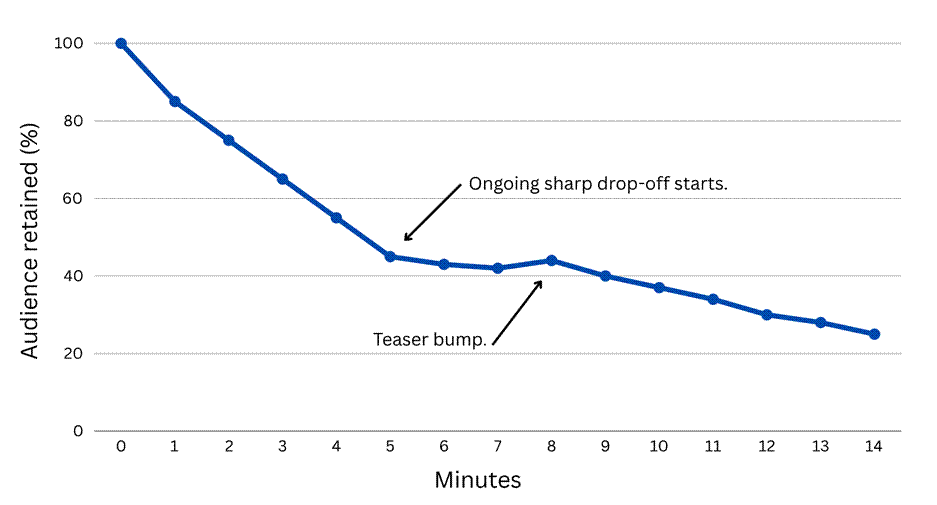Social media marketing has become all about the “hook.” To make it clearer, every marketer would suggest that you ensure the first paragraph (if it’s a written piece) or the first 5 seconds (for video and audio) is so interesting that people decide to keep watching. What we soon realize is that after a strong beginning, we get a high number of views… for the first few seconds, then the interest drops off. Why is this so difficult to deal with, and how can we make the entire content interesting?
Keeping the interest throughout all stages is crucial
Long-form content should not rely on a single burst of intrigue at the beginning – it needs multiple “hooks” or high points to keep the audience invested from start to finish. A useful analogy comes from the poker triple-header, a format designed to maintain engagement throughout the entire gaming session, as players compete in three back-to-back competitive stages, each with its own prize pool and increasing stakes.
Every phase of an online poker triple-header tournament offers its own reward, incentivizing players to stay through all three rounds rather than bowing out after one win. This structure builds anticipation at every phase and leverages the fear of missing out – players stick around knowing that leaving early means missing their shot at the next big payoff.
Of course, modern gaming platforms experiment with many tactics to make sure their games are attractive and captivating, but when you look deeper into the success of a triple-header tournament, it’s clear how unique they are. Because 3 different prizes don’t just mean a bigger budget, but they also mean more chances for different people.
The same principle applies to long-form content as instead of front-loading all the best material at the start, creators can place compelling “mini-hooks” or surprises at various points (early, mid-way, and near the end) to re-capture attention before it wanes. This also allows people with various interests to find something specific throughout the content. In essence, it’s a series of smaller payoffs leading up to a grand finale. This might mean unveiling a striking fact halfway through a blog post or adding an exciting twist in the middle of a video when attention might dip. By structuring content with multiple high-interest moments, you reduce drop-off rates and keep the audience invested longer.
Measuring engagement depth beyond the first click
To improve long-form retention, creators need to look past vanity metrics like view counts and focus on how deeply the audience engages with the content. One key metric is audience retention, often visualized as a drop-off graph or retention curve. Retention data shows exactly how long viewers stick with your video or how far readers scroll through your article, pinpointing where interest starts to fade. Unlike an average watch time or time-on-page number, a retention curve reveals critical points: perhaps many viewers stop around the 5-minute mark or readers quit after the third section. Identifying these drop-offs highlights what might be losing people’s interest – was the introduction strong but the middle too slow, or did a boring tangent cause the audience to leave? With these insights, creators can refine their pacing or content flow accordingly.
The graph below shows an example of a drop in the audience engagement. Pay close attention to the 4-5 minutes, where the steep decline starts.

If analytics show that most visitors only get about halfway through an article and the main payoff of the story comes near the end, most readers will miss it. Using scroll-depth data, you can move critical information higher up or add an engaging element earlier to ensure it’s seen. Similarly, video retention graphs may reveal a sharp drop at a specific timestamp, signaling a cue to tighten or re-edit that segment. Notably, YouTube’s algorithm rewards videos with high retention by boosting them in recommendations.
Another metric to watch is returning audience – the ratio of returning vs. new visitors (or repeat viewers for a channel) gauges how well your content builds loyalty. A healthy share of returning visitors suggests your material was compelling enough to bring people back. For example, the number of readers who subscribe or read another article, or viewers who watch another video on your channel, are telling indicators of retention. These repeat engagement measures, paired with per-piece retention data, paint a picture of not just one successful upload but an ongoing relationship with an audience that values your work.
Turning long-form content into short-form materials
Social media isn’t built for long videos or full articles, and that’s the reason why users get quickly bored of time-consuming materials. This doesn’t mean there is no need for deep content, but it means that long-form creators can and should also amplify their reach by repurposing content into short-form snippets, attracting Instagram Reels, YouTube Shorts, or TikTok viewers. These short clips can grab attention and encourage people to go watch or read the full version. And don’t even think that your content may be so complex that splitting it into small parts would be impossible. Today’s social media influencers successfully present even the most complex games in a few-seconds-long Instagram reel. Take a look at this example:
In practice, a one-hour webinar might yield a dozen 60-second highlight clips. You can create multiple pieces of “micro-content” from one long-form source; for instance, slicing a single video into several Shorts, to engage a broader audience across channels. Keep in mind that there is another type of repurposing when you reuse a TikTok short video for other platforms. These bite-sized pieces act as entry points for new fans: someone who wouldn’t sit through an hour-long podcast might watch a 30-second highlight and then decide to explore the full episode.

